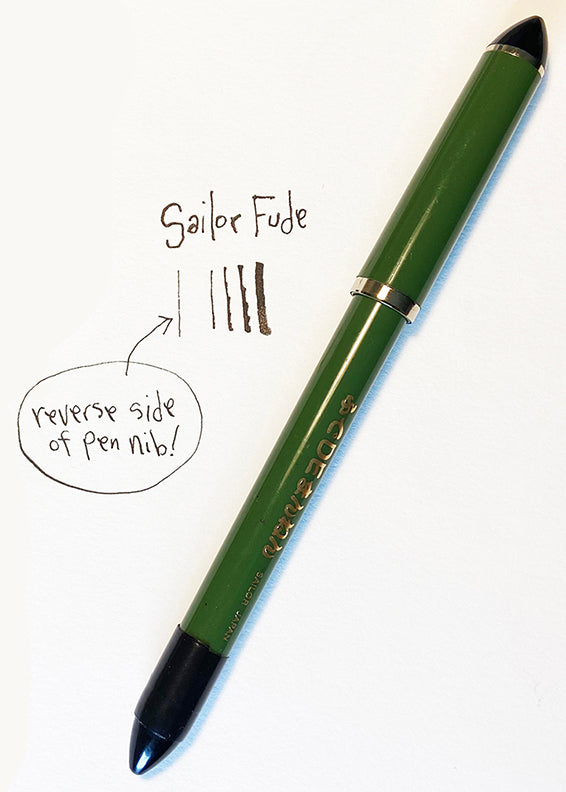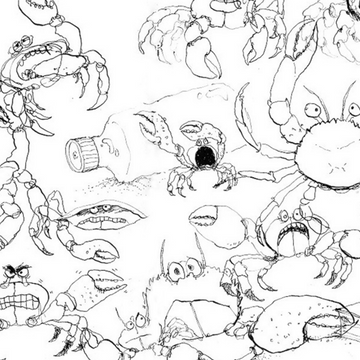
Have you ever drawn with a fountain pen? I draw with one most every day since I don’t have to dip the pen in ink, I can keep on drawing.
I’ll often begin inking a sketch by holding the pen gently and drawing in some thinner lines quickly before flexing the pen’s tines all over the paper for some serious expression.
It’s only more recently that I discovered a fountain pen designed specifically for the Zebra G nib (Ackerman Pump Pen) that works great.
The best part is if you don’t use your pen for several days and the ink clogs or dries, it’s super easy to unclog and get it going again.
Parts

There are really only three main parts to a fountain pen. The nib, the body/reservoir where you’ll fill the pen with ink, and probably the most important part is the feed.
Without a good feed, the ink can’t get to the nib. That means we can’t draw. If the fountain pen requires a converter to put the ink in then add a fourth part. I fill the bod of my pens with ink.
Many fountain pens require you to fill a converter with ink. Depending on how much ink you use, a full converter might not last that long.
Many times you can avoid having to use a converter by simply sealing the end of the body. So, it doesn’t leak and filling it with a fountain pen ink.
Inks

Inks make a big difference in fountain pens. You can’t always tell by touch or looking at the ink, but thinner inks move faster through a fountain pens feed than thicker inks do.
If you use a thicker ink, it might not flow fast enough through the feed for the nib to work properly. “Railroading” is a term used when a fountain pen doesn’t release enough ink on the nib thus producing two parallel lines rather than one.
If this happens, try using a thinner ink. Remember, always use ink that's designed to work with fountain pens.
Using acrylic ink will quickly clog and can even ruin your fountain pen.
Frankenpens
Have you ever tried attaching a dip pen nib to a fountain pen? I have but can only get them to work for a day or two.
And when often drawing, that could be a deal-breaker because you can spend more time getting the pen to work and/or cleaning it than actually drawing.
As you may already know, that’s not fun. I would suggest to anyone who is looking to purchase a fountain pen for drawing to purchase one that comes with the nib you desire.
Trying to create a Frankenpen by combining a dip pen nib with a fountain pen can work, but I have found them to be completely unreliable for anyone who intends to use it regularly.
Flexible Nibs?
I’m always searching for a fountain pen with a nib that delivers the “flex from the past” that I keep hearing fountain pen enthusiasts and collectors talk about.
I’m not a fountain pen collector or an enthusiast but I am a creative person who draws almost every day and needs a dependable fountain pen with a flexible nib.
In an age where Elon Musk has successfully launched and landed the same rocket, why can’t we make fountain pens with ultra-flexible nibs?
Nibs that won’t railroad because the feed is designed to bring all that ink straight to the tines on that nib?
Pen companies are coming out with new fountain pens with stiff nibs all the time yet if you watch and listen to the consumers, much of the excitement is generated from the flexible nibs.
It’s baffling that a company hasn’t capitalized on the market of creatives who like to draw, write, and talk about how great flexible nibs are.
I have seen and bought pens from companies claiming to have flexible nibs but they simply don’t flex like some of the dip pen nibs or vintage fountain pens that have the “flex from the past.”
As a consumer, this tells me that some companies must be aware that “flex” is a selling point, yet there’s only one company producing a fountain pen specifically for a flexible Zebra G nib which is what I use.
If you know what is stopping pen companies from designing dependable fountain pen nibs with a “flex from the past” please let me know.
The Backside

Have you ever turned your fountain pen nib around and used the backside to draw?
Drawing with the backside of the pen can sometimes produce a much thinner line.
For example, take a pen with an extra-fine (EF) nib and flip it over. You are likely to discover that it actually has the capability of producing an extra, extra fine (EEF) line from this reverse side. Pretty cool!
Fude Pen Nib
If you’re in the market for a fountain pen that can create ultra-thin to thick bold lines, check out a fountain pen with a Fude nib.
The nib is not flexible at all but you can achieve line variation by moving your hand up and down while drawing or turning it around to draw on the reverse side.
The reverse side makes an even thinner line. These pens use a lot of ink and are sold with really small reservoir converters which makes me think once again, they’re designed more for the writer than the artist.
I took the converter out of my fountain pen with a Fude nib and used waterproof tape to seal the back of the pen so I can fill the entire body with ink.
It’s a nice hack especially when you’re drawing a lot so you don’t have to fill the pen often.

It’s fun to share my knowledge of fountain pens! It’s even more fun to draw with them. I have a passion and a strong opinion about these tools because I use them each day.
Regardless, It’s important to note that the magic in any drawing we create still comes from within us.
No matter how flexible a pen nib may or may not be, it's our minds, hands, and emotions that we pour onto the paper that makes our drawings unique and truly one-of-a-kind.
Interested in taking a deep dive into inking? Check out our Introduction to Inking course!



